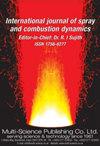Numerical prediction of the ignition probability of a lean spray burner
IF 2.1
4区 工程技术
Q3 ENGINEERING, MECHANICAL
International Journal of Spray and Combustion Dynamics
Pub Date : 2021-06-01
DOI:10.1177/17568277211012536
引用次数: 2
Abstract
The optimization of the igniter position is a critical issue in modern aviation gas turbines since it can help to minimize the amount of energy required for ignition and to guarantee a fast relight in case of flameout. From a numerical perspective, several spark discharges should be simulated for each spark position, to account for different realizations due to time-dependent turbulent motions. Unfortunately, standard simulations are impractical to use for this purpose, due to the need of carrying out several unsteady simulations, leading to a huge associated computational effort. This is why low-order models have been developed, providing an affordable estimation of the local ignition probability, by sacrificing the accuracy and the physical consistency of the prediction. In the present work, a previously developed low-order design model has been implemented in ANSYS Fluent 2019R1® and used to investigate the ignition performance of a single-sector, confined spray flame, where data from laser ignition experiments are available. A non-reactive Large Eddy Simulation, which is validated against experimental data, provides the base flow needed to feed the model. If the tuning parameters of the ignition model are well calibrated, it provides quite good results. In the test case here investigated, it is shown that ignition is possible in the outer recirculation zone and very unlikely elsewhere. Later, a discussion about the effect of the most relevant tuning parameters is carried out. It is shown that the model mostly succeed to identify the area of possible ignition, even if the lack of calibration could lead to a poorer agreement with the experimental data.稀薄喷雾燃烧器点火概率的数值预测
点火器位置的优化是现代航空燃气轮机中的一个关键问题,因为它可以帮助最大限度地减少点火所需的能量,并保证在熄火的情况下快速重新点火。从数值的角度来看,每个火花位置都应该模拟几个火花放电,以说明由于时间相关的湍流运动而产生的不同实现。不幸的是,由于需要进行几次非稳态模拟,因此标准模拟无法用于此目的,这导致了巨大的相关计算工作量。这就是为什么开发了低阶模型,通过牺牲预测的准确性和物理一致性,提供了对局部点火概率的可负担的估计。在本工作中,先前开发的低阶设计模型已在ANSYS Fluent 2019R1®中实现,并用于研究单个扇形、受限喷雾火焰的点火性能,其中可获得激光点火实验的数据。根据实验数据验证的无反应大涡模拟提供了模型所需的基本流量。如果点火模型的调谐参数得到很好的校准,它将提供相当好的结果。在这里调查的测试案例中,表明在外部再循环区点火是可能的,而在其他地方则不太可能。随后,对最相关的调谐参数的影响进行了讨论。结果表明,即使缺乏校准可能导致与实验数据的一致性较差,该模型也能成功地识别出可能的点火区域。
本文章由计算机程序翻译,如有差异,请以英文原文为准。
求助全文
约1分钟内获得全文
求助全文
来源期刊

International Journal of Spray and Combustion Dynamics
THERMODYNAMICS-ENGINEERING, MECHANICAL
CiteScore
2.20
自引率
12.50%
发文量
21
审稿时长
>12 weeks
期刊介绍:
International Journal of Spray and Combustion Dynamics is a peer-reviewed open access journal on fundamental and applied research in combustion and spray dynamics. Fundamental topics include advances in understanding unsteady combustion, combustion instability and noise, flame-acoustic interaction and its active and passive control, duct acoustics...
 求助内容:
求助内容: 应助结果提醒方式:
应助结果提醒方式:


